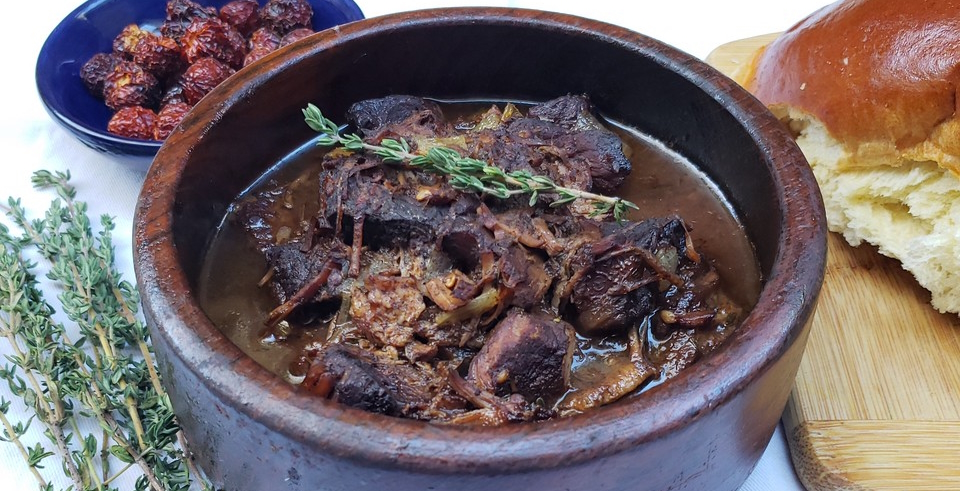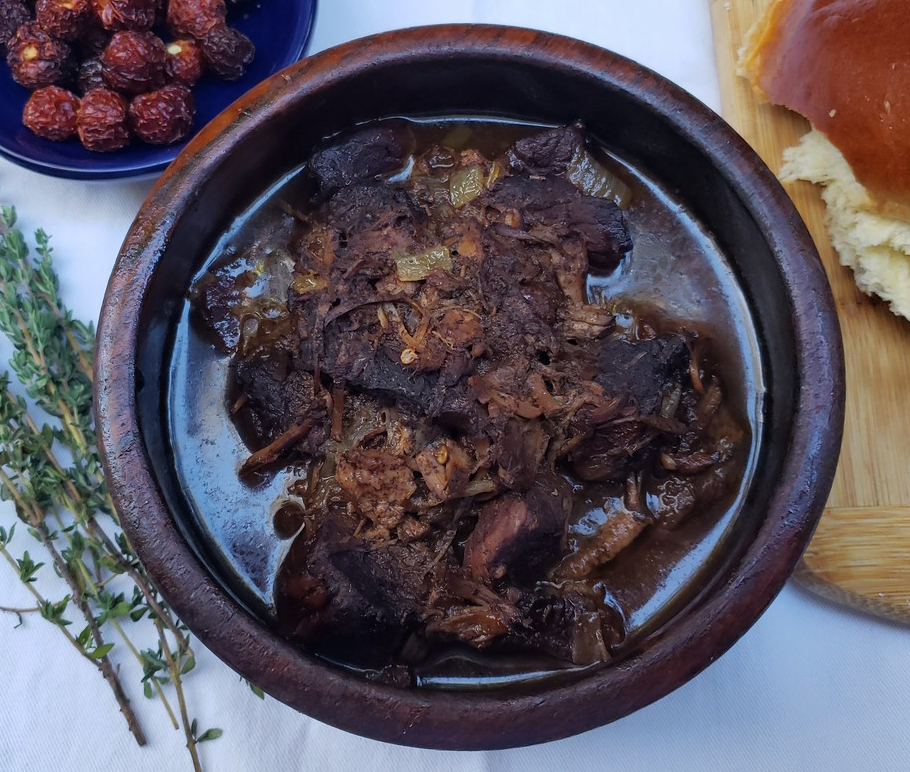Our recipe for this month is Guyanese Pepper Pot. This hearty stew is the go-to meal for Guyanese on Christmas morning, but it can be (and is) eaten at any time of the day and for any occasion.

Located on the North coast of South America, Guyana is home to rich and varied traditions. Influences from Africa, India, Amerindians, Europe, and China all come together to create a unique identity. This mix is evident in their flavorful cuisine, like the spicy pepper pot stew which is our recipe for this month. Music is a vibrant part of Guyanese life, with calypso, chutney, and reggae all popular. As Guyana was a British colony until 1966, English is their official language.
An interesting aspect of pepper pot is that in the 1800's it made its way to the city of Philadelphia and became a hometown classic there. It is even claimed that pepper pot soup helped Washington's troops survive the brutal winter in Valley Forge. The first street vendors in Philadelphia were the "Pepper Pot Women". Philly Pepper Pot was most certainly originally brought to Philadelphia by enslaved (or formerly enslaved) people from West Africa or the Caribbean. Originally it may have even included the use of callaloo greens (a West African green), which over time got replaced by other greens such as spinach. One ingredient (discussed below) used in Guyanese pepper pot is of Amerindian origin: cassareep. It is unclear if this was ever a part of Philly pepper pot. In 1899 Campbell's Soup introduced their own version of pepper pot, and it was sold in the US until 1910 (it can still be found in Canada). The soup's demise in the US was probably caused by the fact that the protein in the soup was beef tripe, which lost favor as Americans became more "sophisticated" in their tastes. Originally the Philadelphia version (of which there are many) held a connection to the Caribbean and Africa not only because of callaloo green but also because of the inclusion of sweet potatoes and other root vegetables. It was the Philly Cheesesteak of its day, and if you were from out of town, you had to try it. I grew up in the suburbs of Philadelphia, and although I don't remember ever trying the restaurant version, the Campbell's was a staple in our cupboard. I don't know if the original Philly version was closer to the Guyanese version, but my memory of the Campbell soup makes me think the similarities shifted substantially through time.
Pepper Pot is the quintessential meal eaten Christmas morning, on New Year's Day, or on any special celebration. Or, again, it can be prepared and eaten any time the mood strikes for this unique blend of flavors. The ingredient that is most distinctive in pepper pot is cassareep sauce. Cassareep is made by pulping a bitter cassava then squeezing the juices out and boiling them for many hours until a dark brown sauce is created. Cinnamon, brown sugar, cloves, and sometimes hot pepper are added to the sauce. Uncooked, bitter cassava is quite toxic as it forms hydrogen cyanide when it is mixed with water! The long cooking process denatures the cassava juices making them perfectly safe to consume. Apparently, virtually no one makes their own Cassareep due to the time-consuming preparation required, and instead, people buy commercially prepared sauce. Cassareep adds a unique flavor to the stew and also imparts a dark brown color. I don't know where it can be found in San Diego, so I bought a bottle on Amazon, and you can too if you use this link (and the WVP gets a tiny fee if you do!). The other special ingredient in Pepper Pot are wiri-wiri peppers. As the recommended substitutes for wiri-wiri peppers are either Scotch bonnets or habaneros, these peppers pack a punch. Again, I found a dried version of these peppers on Amazon, and here is a link to them. Be wary of the "product description" on the Amazon page which says "Wiri Wiri peppers are not a super-hot chili"; these small round chilies tip in at around 250,000 on the Scoville scale. The dried chilies normally have to be soaked in liquid before using them, but as this is a stew, you can just pop them in. I soaked a few in water to test their hotness. and afterward, I cut a tiny slice off of one and tasted it. Mild they are not! I was worried about finding them to pick them out of the cooked Pepper Pot, but that proved futile. My wife and I just forged ahead and ate the pepper pot expecting a big surprise, but that never came. As we have, thus far, only consumed half the pepper pot, perhaps the wiri-wiri are lying in wait for tonight!
Another commonly mentioned aspect of Pepper Pot is that due to the unique preservative powers of cassareep, pepper pot does not have to be refrigerated after it is made. We haven't tested this proposition. Like many stews, pepper pot continues to improve over several days of the ingredients melding together.
Most meats can be used to make pepper pot. We used a combination of beef and pork shoulder. Using oxtails, cow heels, or other bony cuts of beef and pork are also popular. It can be made with chicken, but that is not a common choice. The stew cooks for a long time, so collagen-rich cuts (which used to be the cheaper cuts) are best.
The most common accompaniment to Pepper Pot is plaited bread. Guyanese plait bread is an egg-less, slightly sweet bread that is braided. It is somewhat similar to challah in texture, shape, and taste, so challah can be used as a substitute (and that's what we did).
Cook's notes:
1. We cooked the pepper pot in a thick pot on the stovetop. Using an Instant Pot would speed things up, and cooking foods under pressure often deepens the reach of the seasonings used.
2. One source says that a 1/3 cup molasses, 1 tablespoon soy sauce, and 1 tablespoon Worcestershire sauce can be used as a substitute for the cassareep.
3. Some recipes call for browning the meat. Apparently, this is not common in Guyana because cassareep imparts a dark brown color and a taste similar to what is achieved through browning.
Ingredients:
- 3 pounds of beef or pork or a combination
- 1 cup of cassareep
- 5 cloves of chopped garlic
- 1 medium onion chopped
- 2 tablespoons of fresh thyme (the leaves separated from the stalks)
- 1/2 cup of brown sugar
- 4-8 dried wiri-wiri peppers or 2 finely chopped (use gloves!) habanero peppers
- 4 cinnamon sticks or 2 teaspoons of ground cinnamon
- 1 teaspoon of ground cloves
- 1 teaspoon of ground nutmeg
- Orange peel from one orange (use a peeler to get just the outer part)
- Salt to taste
Preparation:
- Cut the meat into stew-sized cubes.
- Chop the onions, garlic, and thyme with a knife or food processor.
- In a bowl, mix the meat with the other ingredients except the water, and marinate for 1/2 hour.
- Add everything to a large thick-bottomed pot (or Dutch oven).
- Cover with water so that everything is submerged.
- Bring the pot to a boil and then cover and simmer for 1 hour.
Serve with bread or rice.
Recipe and photos by T. Johnston-O'Neill












